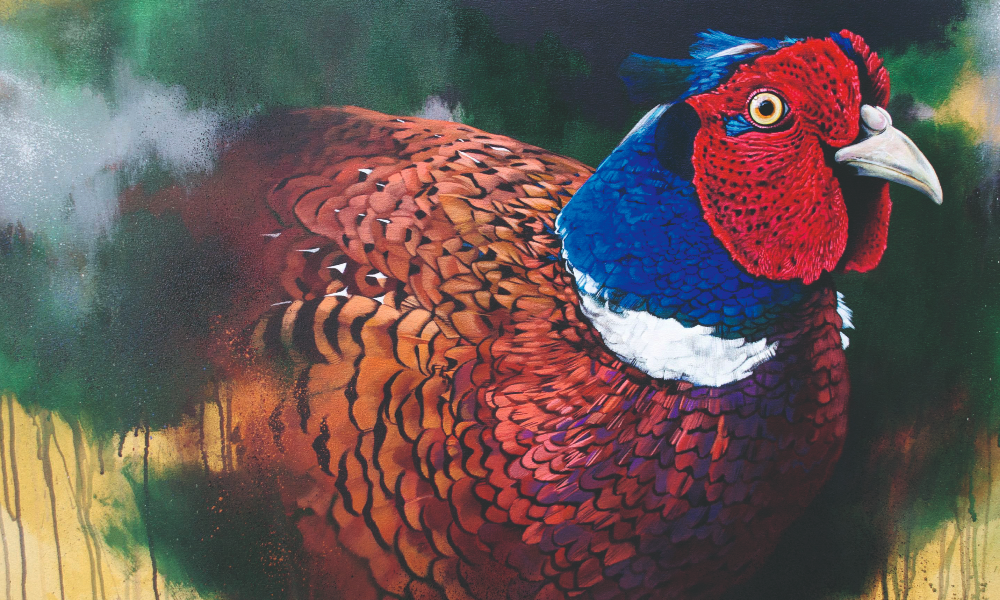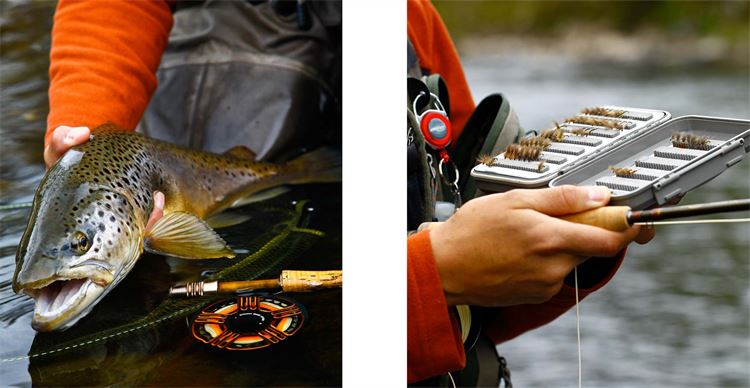Fishing in low water
All is not lost when the water is low, especially for those willing to broaden their horizons explains Steffan Jones.

Come the summer months, us anglers are the antichrist to holidaymakers. When everyone else is wishing for prolonged dry and sunny weather, salmon anglers are praying for summer spates.
Faced with a drought, most of the rivers become devoid of activity. The vast majority of anglers hang up their rods, choose not to travel, and forfeit expensive trips as a result.
If you are transfixed with salmon, there is little cure to the low water ailment. First and last light undoubtedly give the best chances, especially if the forecast is for a bright and windless day. However, all is not lost, especially for those willing to broaden their horizons and adapt to the cards they’re dealt. The secret is to fish the conditions, or more accurately, fish for what the conditions present.
Prevailing conditions perceived as unfavourable for one species are often acceptable for another. Most rivers are fortunate to have contingencies, as long as you are willing to explore them. There is no place for species snobbery when faced with such conditions – those of such a mindset are better off staying at home. For those with the outlook that any fishing is better than no fishing, a whole new world begins to open up and amazing fishing awaits.
Of course, should the water be very warm and fish revival be an issue, then all species are best left alone. If not, they are fair game and, with the correct tackle, will provide hours of fun. If the river has a decent head of brown trout, then this is certainly the first avenue to explore. Even in the lowest of low water, the trout should still be feeding. You will find them near the surface in the shade, or tempted in the runs and riffles with a nymph. However, it is the evening fishing that really provides spectacular sport under such conditions and this is what should be targeted in earnest.
During hot, summer days hatches will most likely be sporadic. The flies will prefer to wait until the sun is low on the horizon and the warmth of the day has begun to abate before hatching. Leading up to darkness, you may have two hours or so of prolific sport. You will have the newly hatched duns but also the returning spinners creating an amalgamating veritable feast. From a dormant river, devoid of life by day, the river may erupt into life.
The daytime should not be wasted, even if the main event is not until the evening. Study the river, look for structure, identify where a solitary, larger fish may choose to live – they will likely hold court in a pool. When the light fades and such fish emerge, time to target them may be limited, so you do not want to waste time targeting the sentries when you have a chance at the king.
The set-up need not be complicated. A 9ft #4 or #5 rod is perfect when combined with a floating line. On the end, a tapered leader is highly recommended, with the overall leader being as long as you can manage; the longer leader will enable a delicate presentation, which may be the difference between success and failure in such conditions. A length of 12–15ft is commonplace and 18ft+ is certainly not unheard of. Basically, fish as long as you are comfortable with and do not be shy about reducing the length as the light fades; it becomes increasingly difficult to gauge distance as light levels diminish. The fish also become less wary as it grows dark, becoming more approachable and therefore more catchable.
If you know what is hatching – local advice will always provide such nuggets of information – then you may travel light. A handful of flies is all that’s required. In the height of summer, you’re likely to have blue-winged olives, perhaps some olive uprights, then a couple of sedge patterns. Carry dun and spinner patterns to cover the olives, then an emerger and a very buoyant adult version for the sedge. Do not overcomplicate things, because such situations are rarely complicated. Match the hatch – it is that simple. When the light fades to a degree where the pattern may no longer be monitored, switch to the adult sedge pattern, as sedges will often hatch late into the night. They will hatch then scurry for the nearest bank or boulder. As such, whereas the olive patterns preferably need to be fished dead-drifted, you may swing and skate the sedge to mimic the natural offering. The takes can be explosive and less finesse is needed in the approach.
Beyond the small selection of flies, you should carry some floatant, some grease (such as Mucilin), some degreaser/mud, a fly dryer and some tippet material. You may add tippet material onto the end of whichever tapered leader you choose. I would recommend carrying a spool of 3lb and 4lb tippet (0.13–0.15mm in diameter). Add the material when there is a lot of residual light, then cut it off as you venture further into darkness. Apply Mucilin to the tapered leader and the last couple of metres of your fly line, but not to the tippet – you want the fly line and tapered leader floating high, which will aid presentation and line control. You want the tippet material to be as inconspicuous as possible.
Another species that reigns supreme under such conditions is the silver ghost, the hidden gem, the underrated target: the humble sea trout. In contrast to salmon, sea trout will literally run with their backs out of the water. I hear anglers lamenting the lack of rain each and every season, and I grimace at the notion. In fact, when the sea trout are present, rain is the last thing I want, especially when I am targeting them at night.
The ideal night-time conditions are largely the polar opposite of what one desires from a salmon fishing perspective. Ideally the water needs to be gin clear; the clarity is essential when night fishing as you must work with reduced light level to cast a silhouette. The sediment from coloured water blocks light penetration and, in turn, inhibits silhouette formation. If the fish cannot see the fly, they cannot take the fly.
Why low water? I actually want the river on its bones! The reason for this is simple; when you find the fish, they will usually be in a concentration and are also unlikely to move. Fish look for other fish and what suits one fish will usually suit a mass. Over a mile of water and faced with a spate, the fish may be distributed over five or more pools. However, given summer conditions over the same stretch of river, the fish may then be restricted to perhaps two holding pools. It is all about the process of elimination and essentially most other pools will not hold the fish en masse as they cannot afford the sanctuary the larger holding pools do.
Even the warmer water helps with the sport somewhat. We’re not talking about extremes, but certainly into the low and mid-teens celsius-wise. These temperatures make the fish extremely active and willing to react towards and on the surface, especially if presented with optimal weather. An overcast sky is key, as this locks in the daytime temperature and prevents the dreaded mist forming on the water.
Contrary to popular belief, sea trout do feed in freshwater, especially the school fish (fish up to around 2-3 lbs or so). There are two factors that dictate this, one being length of exposure to saltwater, and the other being necessity because of fat reserves. It is rare to see larger fish feed, but they can most certainly be tempted, like a salmon. As a result, when fishing with a dry fly at dusk, what you think is a brown trout may well turn out to be a sea trout. Indeed, I target sea trout with a dry fly every season nowadays – if you know your river well and the haunts of the larger brown trout, then you will know that when a larger fish moves in a peculiar spot, the chances are it’s a sea trout.
Small wet flies fished through the heads of the pools and faster runs and glides will often provide results, too. Sea trout, brown trout and even salmon will fall victim to such tactics. Fished on a straight floater or short intermediate tip, two wet flies should be fished around five feet apart. Fish them fast; this is one of the biggest faults I see when it comes to anglers targeting sea trout. The fish will almost always prefer something moving too quickly rather than too slowly, as it draws a snatch reaction. Fish through the water quickly, too; a sea trout will most likely take on the first cast or not at all. Repetitive casts become redundant.
When faced with low water, it is worth focusing on fishing under the full cover of darkness. This is some of the most exhilarating fishing to be found anywhere. The tug is most certainly the drug and at no time does this carry more truth than when a sea trout is attached to your line at night. When darkness falls your senses are heightened, with a take passing through your line like an electric charge.
Daytime reconnaissance is essential. Get to know the pool you’re going to target at night; even wade through and wet a line by day so that you’re confident with your surroundings. For most rivers a 10ft #7 or #8 rod is perfect. There’s no need to overcomplicate the line selection under such conditions either; a floater is essential, married with some tips or with an intermediate carried on a spare spool. Even in the lowest of water I like fishing with a short intermediate tip, just to cut the flies through the surface – you will often find the takes to be more confident as a result. There are times, however, when the fish will react aggressively on the surface, hence why surface patterns were invented and deployed.
Fish a light leader at your peril – sea trout are not leader shy at night, so there is no need to entertain anything lighter than 12lb. Fly selection is also relatively simple: as a rule of thumb, fish patterns of and over 1″ at night. Think silhouette, length and profile, with colours becoming largely materialistic. Black casts the strongest silhouette, hence why it appears in many sea trout flies. Adjust the size of the fly according to the amount of residual light; the more light present, the smaller the fly should remain. As it gets darker, the size of your fly should increase, too.
With this information to hand, don’t hang up your rod or forfeit a trip the next time you are presented with drought conditions, as you may well be missing out on an untapped gem.
Related Articles
Get the latest news delivered direct to your door
Subscribe to Fieldsports Journal
Elevate your experience in the field with a subscription to Fieldsports Journal, the premium publication for passionate country sports enthusiasts. This bi-monthly journal delivers unparalleled coverage of game shooting, fishing and big game across the UK and beyond.
Each issue offers a stunning collection of in-depth features, expert opinions and world-class photography, all presented in a timeless yet contemporary design.
Save 10% on shop price when you subscribe, with a choice of packages that work for you. Choose from Print & Digital or Digital only with each journal delivered directly to your door or via the app every other month, plus access to past issues with the digital back issue library.










